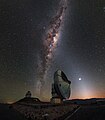Timeline of telescopes, observatories, and observing technology.

The European Organisation for Astronomical Research in the Southern Hemisphere, commonly referred to as the European Southern Observatory (ESO), is an intergovernmental research organisation made up of 16 member states for ground-based astronomy. Created in 1962, ESO has provided astronomers with state-of-the-art research facilities and access to the southern sky. The organisation employs over 750 staff members and receives annual member state contributions of approximately €162 million. Its observatories are located in northern Chile.

The Boomerang Nebula is a protoplanetary nebula located 5,000 light-years away from Earth in the constellation Centaurus. It is also known as the Bow Tie Nebula and catalogued as LEDA 3074547. The nebula's temperature is measured at 1 K making it the coolest natural place currently known in the Universe.

Observational astronomy is a division of astronomy that is concerned with recording data about the observable universe, in contrast with theoretical astronomy, which is mainly concerned with calculating the measurable implications of physical models. It is the practice and study of observing celestial objects with the use of telescopes and other astronomical instruments.

The Atacama Large Millimeter/submillimeter Array (ALMA) is an astronomical interferometer of 66 radio telescopes in the Atacama Desert of northern Chile, which observe electromagnetic radiation at millimeter and submillimeter wavelengths. The array has been constructed on the 5,000 m (16,000 ft) elevation Chajnantor plateau - near the Llano de Chajnantor Observatory and the Atacama Pathfinder Experiment. This location was chosen for its high elevation and low humidity, factors which are crucial to reduce noise and decrease signal attenuation due to Earth's atmosphere. ALMA provides insight on star birth during the early Stelliferous era and detailed imaging of local star and planet formation.
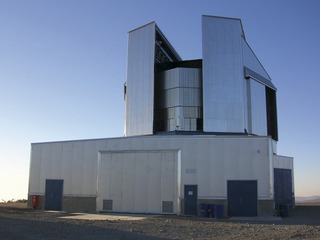
The VISTA is a wide-field reflecting telescope with a 4.1 metre mirror, located at the Paranal Observatory in Chile. It is operated by the European Southern Observatory and started science operations in December 2009. VISTA was conceived and developed by a consortium of universities in the United Kingdom led by Queen Mary University of London and became an in-kind contribution to ESO as part of the UK's accession agreement, with the subscription paid by the UK Science and Technology Facilities Council (STFC).

La Silla Observatory is an astronomical observatory in Chile with three telescopes built and operated by the European Southern Observatory (ESO). Several other telescopes are located at the site and are partly maintained by ESO. The observatory is one of the largest in the Southern Hemisphere and was the first in Chile to be used by ESO.

Onsala Space Observatory (OSO), the Swedish National Facility for Radio Astronomy, provides scientists with equipment to study the Earth and the rest of the Universe. The observatory operates two radio telescopes in Onsala, 45 km south of Gothenburg, and takes part in several international projects. Examples of activities:
The Joint Institute for Very Long Baseline Interferometry European Research Infrastructure Consortium (JIVE) was established by a decision of the European Commission in December 2014, and assumed the activities and responsibilities of the JIVE foundation, which was established in December 1993. JIVE's mandate is to support the operations and users of the European VLBI Network (EVN), in the widest sense.
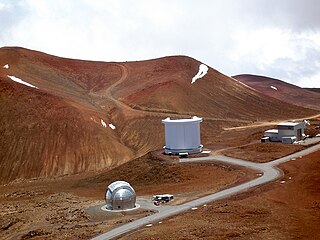
The James Clerk Maxwell Telescope (JCMT) is a submillimetre-wavelength radio telescope at Mauna Kea Observatory in Hawaii, US. The telescope is near the summit of Mauna Kea at 13,425 feet (4,092 m). Its primary mirror is 15 metres across: it is the largest single-dish telescope that operates in submillimetre wavelengths of the electromagnetic spectrum. Scientists use it to study the Solar System, interstellar dust and gas, and distant galaxies.

Submillimetre astronomy or submillimeter astronomy is the branch of observational astronomy that is conducted at submillimetre wavelengths of the electromagnetic spectrum. Astronomers place the submillimetre waveband between the far-infrared and microwave wavebands, typically taken to be between a few hundred micrometres and a millimetre. It is still common in submillimetre astronomy to quote wavelengths in 'microns', the old name for micrometre.

The Atacama Pathfinder Experiment (APEX) is a radio telescope 5,064 meters above sea level, at the Llano de Chajnantor Observatory in the Atacama desert in northern Chile, 50 km east of San Pedro de Atacama built and operated by 3 European research institutes. The main dish has a diameter of 12 m and consists of 264 aluminium panels with an average surface accuracy of 17 micrometres (rms). The telescope was officially inaugurated on September 25, 2005.

Llano de Chajnantor Observatory is the name for a group of astronomical observatories located at an altitude of over 4,800 m (15,700 ft) in the Atacama Desert of northern Chile. The site is in the Antofagasta Region approximately 50 kilometres (31 mi) east of the town of San Pedro de Atacama. The exceptionally arid climate of the area is inhospitable to humans, but creates an excellent location for millimeter, submillimeter, and mid-infrared astronomy. This is because water vapour absorbs and attenuates submillimetre radiation. Llano de Chajnantor is home to the largest and most expensive astronomical telescope project in the world, the Atacama Large Millimeter Array (ALMA). Llano de Chajnantor and the surrounding area has been designated as the Chajnantor Science Reserve by the government of Chile.

An astronomical interferometer or telescope array is a set of separate telescopes, mirror segments, or radio telescope antennas that work together as a single telescope to provide higher resolution images of astronomical objects such as stars, nebulas and galaxies by means of interferometry. The advantage of this technique is that it can theoretically produce images with the angular resolution of a huge telescope with an aperture equal to the separation, called baseline, between the component telescopes. The main drawback is that it does not collect as much light as the complete instrument's mirror. Thus it is mainly useful for fine resolution of more luminous astronomical objects, such as close binary stars. Another drawback is that the maximum angular size of a detectable emission source is limited by the minimum gap between detectors in the collector array.
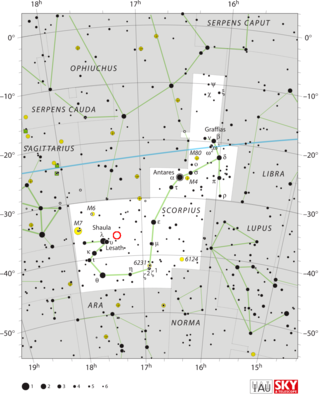
NGC 6334, colloquially known as the Cat's Paw Nebula, Bear Claw Nebula, or Gum 64, is an emission nebula and star-forming region located in the constellation Scorpius. NGC 6334 was discovered by astronomer John Herschel in 1837, who observed it from the Cape of Good Hope in South Africa. The nebula is located in the Carina–Sagittarius Arm of the Milky Way, at a distance of approximately 5.5 kilolight-years from the Sun.
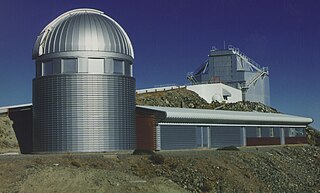
Leonhard Euler Telescope, or the Swiss EULER Telescope, is a national, fully automatic 1.2-metre (47 in) reflecting telescope, built and operated by the Geneva Observatory. It is located at an altitude of 2,375 m (7,792 ft) at ESO's La Silla Observatory site in the Chilean Norte Chico region, about 460 kilometers north of Santiago de Chile. The telescope, which saw its first light on 12 April 1998, is named after Swiss mathematician Leonhard Paul Euler.
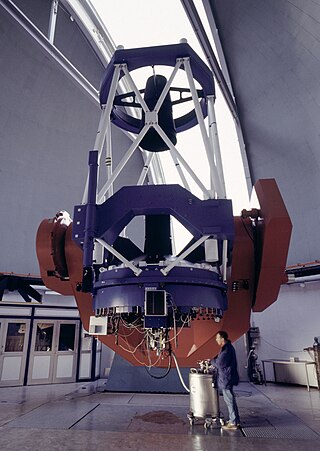
The MPG/ESO telescope is a 2.2-metre f/8.0 (17.6-metre) ground-based telescope at the European Southern Observatory (ESO) in La Silla, Chile. It was built by Zeiss and has been operating since 1984. It was on indefinite loan to the European Southern Observatory from the Max Planck Institute for Astronomy (MPIA). In October 2013 it was returned to the MPIA. Telescope time is shared between MPIA and MPE observing programmes, while the operation and maintenance of the telescope are ESO's responsibility.
Science tourism is a travel topic grouping scientific attractions. It covers interests in visiting and exploring scientific landmarks, including museums, laboratories, observatories and universities. It also includes visits to see events of scientific interest, such as solar eclipses.


